So, what’s an All Lines Rail Rover (ALRR)? It’s a train ticket that lets you go anywhere on the national rail network, with very few restrictions. I always said that the minute I was made redundant I’d buy a 14 day first class ALRR, and I achieved both those goals in 2006. Since then I’ve gone away for 7 days every two or three years. I’ve now covered a large chunk of the network, from Wick to Penzance and Holyhead to Ramsgate, but there’s plenty left to do. I find I now spend less time on fast long-distance trains and more on local services, filling in the gaps by pottering around various cities and counties. Having done this now for several years I’ve seen change on the railways, and there’s plenty more of that to come, mostly for the better.
This year’s ALRR wasn’t really planned in that I made the decision to go then set off a couple of days later with no more than a vague wish list, most of which I did not achieve. The following is a description of my 2019 ALRR, warts and all.
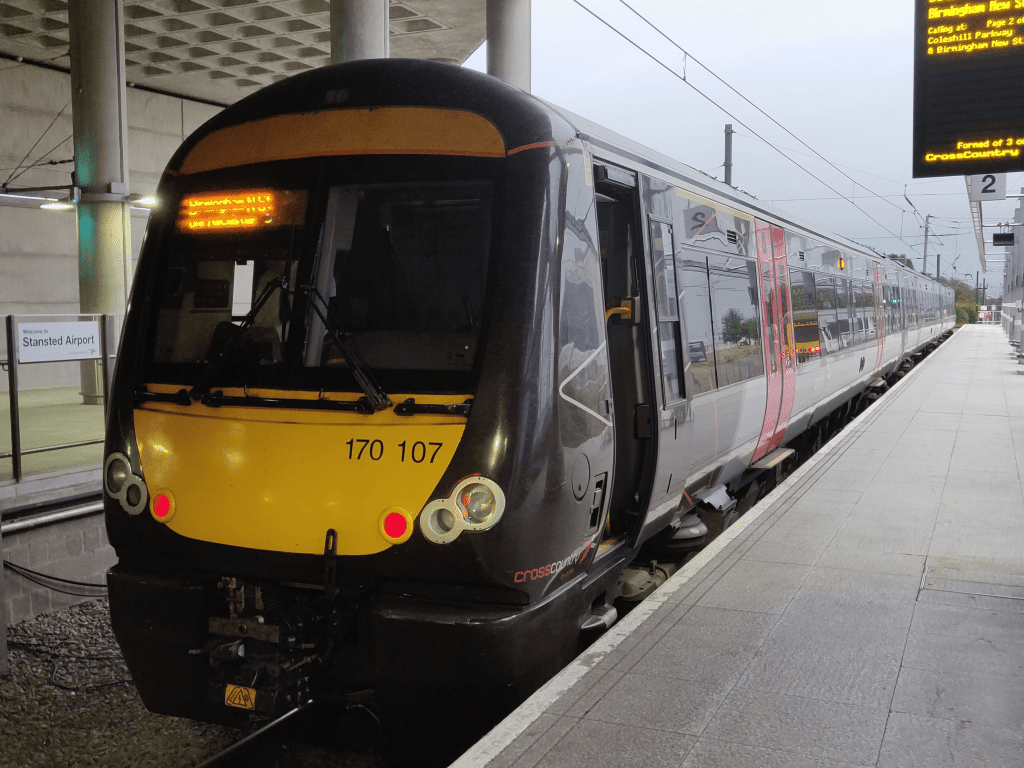
Train 1
Service: 1N43 0627 Stansted Airport to Birmingham New Street
Operator: CrossCountry
Class: 170 (170107)
My journey:
Stansted Airport to Peterborough
Stats: 69.7 miles, 6 stops in 1:24 (49.8 mph)
It was already light as I walked to the end of the lane to catch the bus to Stansted Airport, my starting place for this year’s train trip. In previous years it’s sometimes been pitch dark and pouring with rain as I started. But despite the relatively good conditions there were severe weather warnings for rain in many parts of the country. I’ll just have to keep my fingers crossed.
The bus to the airport runs all night. It’s been hourly up to now, but this journey is 30 minutes after the previous one. I fired up the Arriva bus app. I’d checked it earlier and was pleased to see that it provides real-time information about where the buses actually are. I can see that the previous bus ran on time, but my bus seems to be off the air.
Bugger. Not a good start.
If the bus is cancelled what are my options? The bus in the opposite direction is due in ten minutes, leaving from a stop about 100m along the road and taking me to Bishop’s Stortford in time for a train that would leave today’s plan intact. Convinced that my bus wasn’t going to arrive, I set off along the road to a place where I could cross. Naturally, when I turned back to look for a gap in traffic, I saw my bus hurtling round the bend.
My days of running for public transport are over. Not only am I unfit, but it isn’t dignified. The only acceptable thing for an Englishman to do if his bus or train arrives when he’s too far away to catch it at a gentle stroll is to act as if he never intended to catch it in the first place. I’m afraid that I forgot myself and let my countrymen down. Reader, I ran for that bus.
It got me to the airport in time to buy the first of many black Americanos before boarding the first train of my adventure. This was a CrossCountry service for Birmingham New Street, although I was only going as far as Peterborough. I’ve used this line many, many, times, preferring to change at Peterborough when heading north rather than travel via London. It’s fine, but as the trains are never more than three cars long they’re hopeless at busy times.
The journey to Peterborough is via Cambridge then over the Fens and brickfields to Peterborough. There’s a lot of water around as you cross the fens. In winter you seem to be crossing a large lake that goes on for miles. This might sound boring but travellers are cheered up by the occasional thump and flurry of feathers as another pigeon mistakes a 90 mph train for a safe place to roost.
There are many wind turbines on this line because of the flat terrain. Overall, that seems to me a good thing. You may differ.
For a long time now there have been speed restrictions over long sections of this line, particularly over bridges. This is still the case as we spent a long time crawling at no more than 30 mph. The decks of these bridges seem to have been recently replaced (or covered) with perforated metal rather than the wood that used to be there. Maybe they’ll soon be able to raise the limit.
The brickfields on this line make Fletton bricks, the ugly ones in various shades of red, and I can’t pass by without remembering my school trip in the early ‘70s. We walked right inside a London Brick Company kiln, still warm from its last firing. Our guide instructed us to keep to the walls of the kiln, in case any bricks dropped onto our heads. He also told us an interesting fact about the Fletton. The clay used has enough combustible material to avoid the need to add fuel when firing. Presumably you need to start them off somehow, but then they fire themselves.
Not so long ago the signalling along the line between Ely and Peterborough was mechanical, with semaphore signals. Most of them have now been replaced with modern colour light signals. Which is a shame for people like me who find the old signal arms somehow reassuring. But it reduces costs and increases safety. Luckily for people like me there are still a few semaphores remaining on the running lines, particularly at Whittlesea, and around the the yards at March, although most of those at March are small shunting arms.
We reached Peterborough on time and without incident. I was now on the East Coast Main Line, one of the country’s main transport trunks, linking London with Yorkshire and Scotland. There would be no mechanical signalling on this line.
Train 2
Service: 1S05 0700 Kings Cross to Edinburgh Waverley
Operator: LNER
Class: 91+Mk4+DVT (91114)
My journey
Peterborough to Edinburgh
Stats: 318.8 miles, 5 stops in 3:29 (90.9 mph)
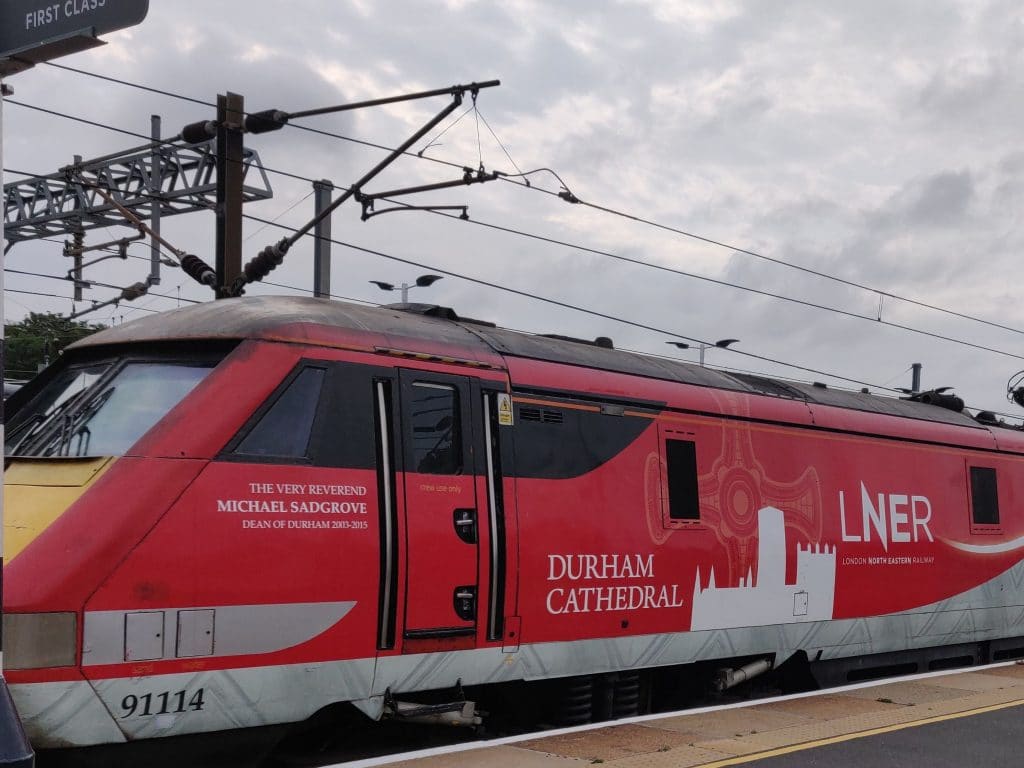
I was supposed to wait nearly half an hour for my next train, to Edinburgh, and the platform was packed. A Saturday morning during the summer holidays is still a busy time on long-distance trains. Most were waiting for a train that should have arrived a few minutes earlier, also an Edinburgh service. It arrived almost immediately so I joined the hordes struggling to board. I was now nearly an hour ahead of schedule.
The train was packed. Even in first class, affordable at the weekend, well over half of the seats were taken. But I managed to grab a table for two facing the direction of travel and waited for my first cup of free railway tea. Less than three and a half hours later I was in Scotland’s capital, having got there from Peterborough at an average speed of 91 mph. This would be one of my last trips on LNER’s Mk. 4 carriages as they’re currently being replaced by Hitachi Azumas. These will shorten journey times on this route, but will they be as comfortable? I doubt it.
I remember visiting Edinburgh on a train trip in 2012. Waverley station was a noisy, dusty, building site and outside there was torrential rain. It was the wettest summer for 100 years. Well, the building works are finished but the rain doesn’t seem to have abated one bit. The locals must be getting quite fed up with it. I had an hour to kill and could do with some food, but where? I saw there was a pub called the Booking Office very close to the station, up on Waverley Bridge, so I used breast stroke to get through the floods up the ramp and along to the pub door. It was a nice looking building.
I fought my way inside, squeezing past groups of tourists using the Wetherspoons as a free umbrella. Wetherspoons. The very word instils dread. I hate the places, and this was typical of all that’s bad. Despite it not yet being noon, it was packed. Every seat taken and dozens, or hundreds, standing. It was deafeningly noisy and I had to keep moving to allow people to seep past. There were several stag and hen groups, one of them in fake Scots costume of kilt and Tam O’Shanter with ginger wig. It was so crowded that it would take more time and effort than I was prepared to invest to get near the bar, let alone served. I used the gents (quite good – Wetherspoons toilets usually are) and snorkelled back down to the station for some Marks’ food.
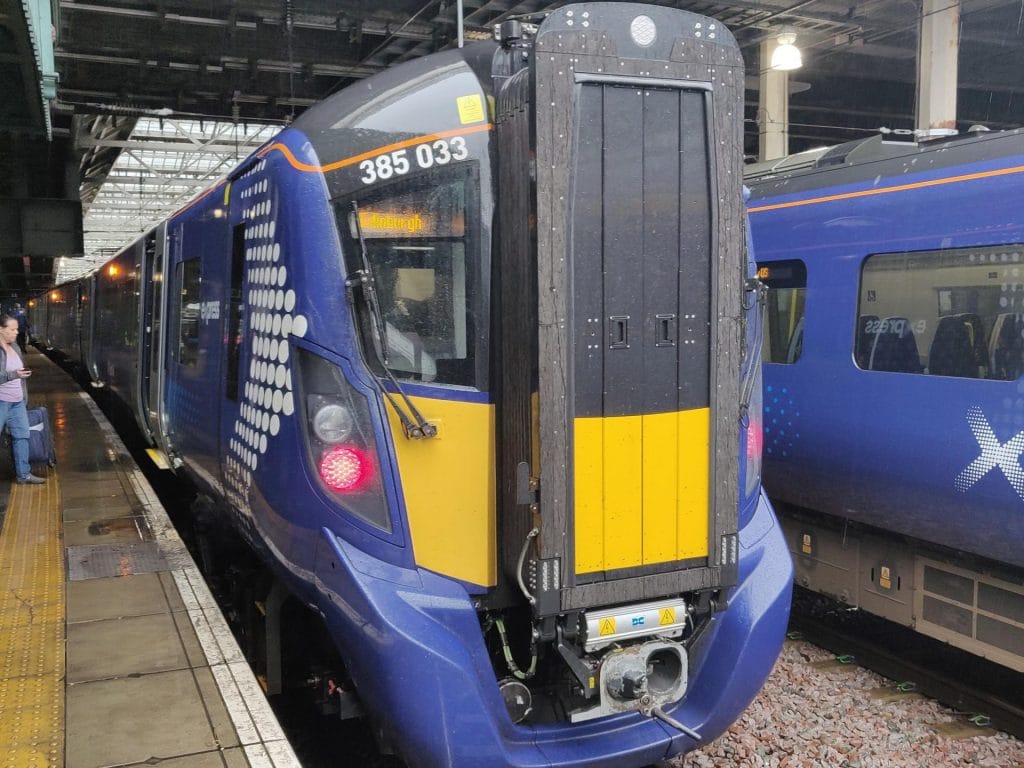
Train 3
Service: 2Y41 1227 Edinburgh to Glasgow Central via Shotts
Operator: ScotRail
Class: 385 (385033)
My journey
Whole route
Stats: 47 miles, 19 stops in 1:27 (32.4 mph)
I needed to head west, to Glasgow. There are no fewer than five rail routes between Edinburgh and Glasgow these days. Three of them, including the fast, frequent line via Falkirk High, go to Glasgow Queen Street. I wanted Glasgow Central. I used the newly electrified line via Shotts. The train was one of ScotRail’s new class 385s. They’re plug-ugly but nice trains to travel in: bright, comfortable and smooth. The journey was reasonably interesting. We left Edinburgh via Haymarket, travelling through commuter towns then skirting the south of Livingstone before continuing through open country. Like much of the central belt there was once a lot of industry along this line, including the odd colliery, but I saw no remaining evidence. I certainly had time to enjoy the scenery as the train stopped 19 times over its 47 mile journey.
Train 4
Service: 1A10 1413 Glasgow Central to Stranraer
Operator: ScotRail
Class: 156 (156467)
My journey
Whole Route
Stats: 98.9 miles, 13 stops in 2:37 (37.8 mph)
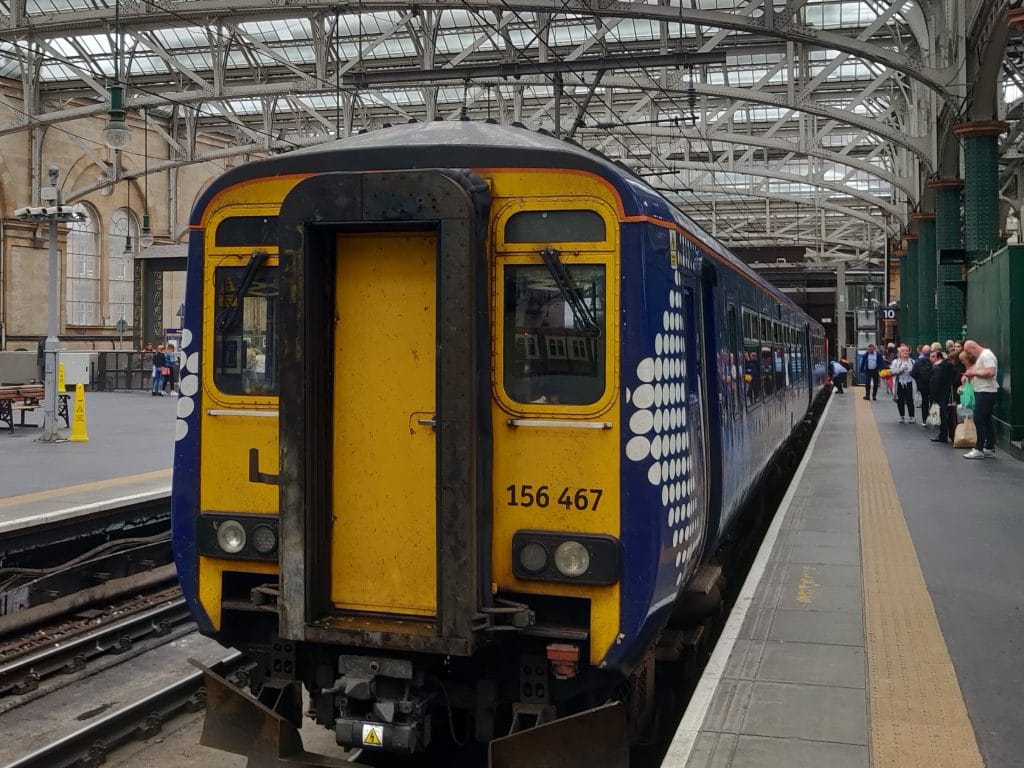
I only had 20 minutes until my next train, to Stranraer. I’ve always wanted to go there by train, and always failed. Last time I got as far as Girvan before I spent too long over a splendid Full Scottish Breakfast and missed the onward train. This time there would be no breakfast so no excuses.
The Glasgow suburbs were quickly left behind as we passed oddly named stations such as Crossmyloof and Pollockshaws West. After Barrhead the line is mostly single, running down through Dunlop and Stewarton to Kilmarnock. Kilmarnock is a lovely station, with ornate buildings and a partly-glazed roof spanning not just the platforms but also the tracks of the bay platforms there.
The line continues to Dumfries and Carlisle, but we reversed in Kilmarnock and branched to the left, heading for the coast and joining the Glasgow – Ayr line at Barassie. We passed Troon and Prestwick Airport before arriving at Ayr, passing golf links with the sea behind. The line from Glasgow to Ayr is a double track electric commuter line. Beyond Ayr its character changes. It becomes single track, unelectrified and very rural indeed. The line heads inland to Maybole then back to the coast at Girvan. It’s back inland again as we go to Barrhill and finally, back on the coast, Stranraer Harbour, the station overhanging the sea.
The views on this line are great. Rolling hills with streams and stone bridges. There are few building or other signs of habitation. It’s lines like this that make me do these trips. I just love rattling along through the countryside.
Rattling? Yes, parts of the line still have jointed track, making the once-familiar clicketty-clack noise as the wheels pass over the joints. That’s a bit of a throw-back, but other aspects of the line are even more so. The final two stations on the line, Barrhill and Stranraer Harbour, are 25 miles apart. The line between them is single track with passing places at Glenwhilly and Dunragit. The stations and passing places have traditional signal boxes, those at the passing places possibly the most isolated signal boxes left on the network. These signal boxes keep us safe using a system called electric token block, the last such installations on the national rail network.
I’ll explain how this works, so if you’re geek-averse skip this and the following couple of paragraphs. Most railway signalling keeps trains safe by breaking up the line into a series of blocks (or sections) and ensuring that only one train can be present in each block. But single track lines, where a train can travel in either direction, complicates this. A common solution was to have a physical object, a token, that the driver must have in his possession before entering the section. This is safe but is only a partial solution because of the problem of trains travelling in both directions. What if a second train wants to pass through in the same direction as the first? The token is now at the wrong end of the block. Various solutions have been used including, in extreme cases, the token being ferried by road to the other end of the block. Electric token block is the elegant solution used here.
When a train is approaching the entrance to a single line section the signaller releases a token from a token machine, which may contain up to 30 tokens. He/she can only release a token if the signaller at the far end cooperates by pressing a release their end. The signaller then leaves the box and stands in the rain, handing the token to the driver. The driver checks that it’s the correct token for the section in point, the signaller clears the signal and the train proceeds. Now that a token has been issued the token machines at each end automatically lock and will not release another token, keeping the train safe despite there being multiple tokens in existence for the block.
At the far end of the single-line section the driver hands the token to the signaller there who places it in his token machine. Now the machines are unlocked and another token may be issued allowing another train to pass through, whichever direction it is travelling in.
As you’d expect from such an antiquated line it’s still got proper semaphore signals, including yellow and black distant signals. They’re becoming quite rare.
The weather continued to be atrocious. The poor old signallers were getting soaked. The train was taking a hammering, too, as lineside foliage, weighed down with rain, kept thumping the carriage corners to the extent that I’m sure damage must have occurred. The view from the window was spoilt by the rain, but it did ease off from time to time showing rivers and burns in spectacular full spate.
Eventually we reached Stranraer. There are few passengers by this point. Stranraer no longer has the Belfast ferry service as that has moved along the loch to Cairnryan. Foot passengers now leave the train at Ayr and travel by coach to the ferry. Yet Stranraer Harbour station survives. It no longer has trains to Carlisle, as it did until recently, let alone the services that once ran deep into England. All that’s left is a train about every two hours, mostly going no further than Kilmarnock.
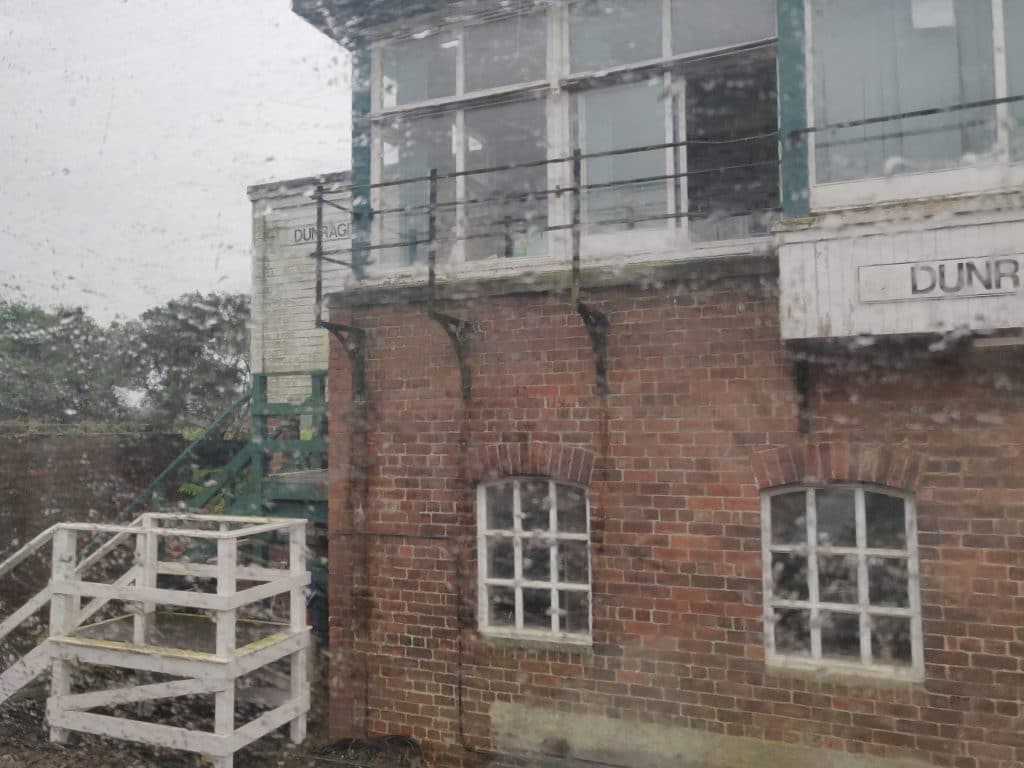
Train 5
Service: 1A03 1659 Stranraer to Glasgow Central
Operator: ScotRail
Class: 156 (156467)
My journey
Stranraer to Glasgow Central
Stats: 59.2 miles, 6 stops in 1:22 (43.3 mph)
Train 6
Service: 1K54 1825 Ayr to Glasgow Central
Operator: ScotRail
Class: 380 (380009)
My journey
Whole Route
Stats: 41.4 miles, 7 stops in 0:45 (55.25 mph)
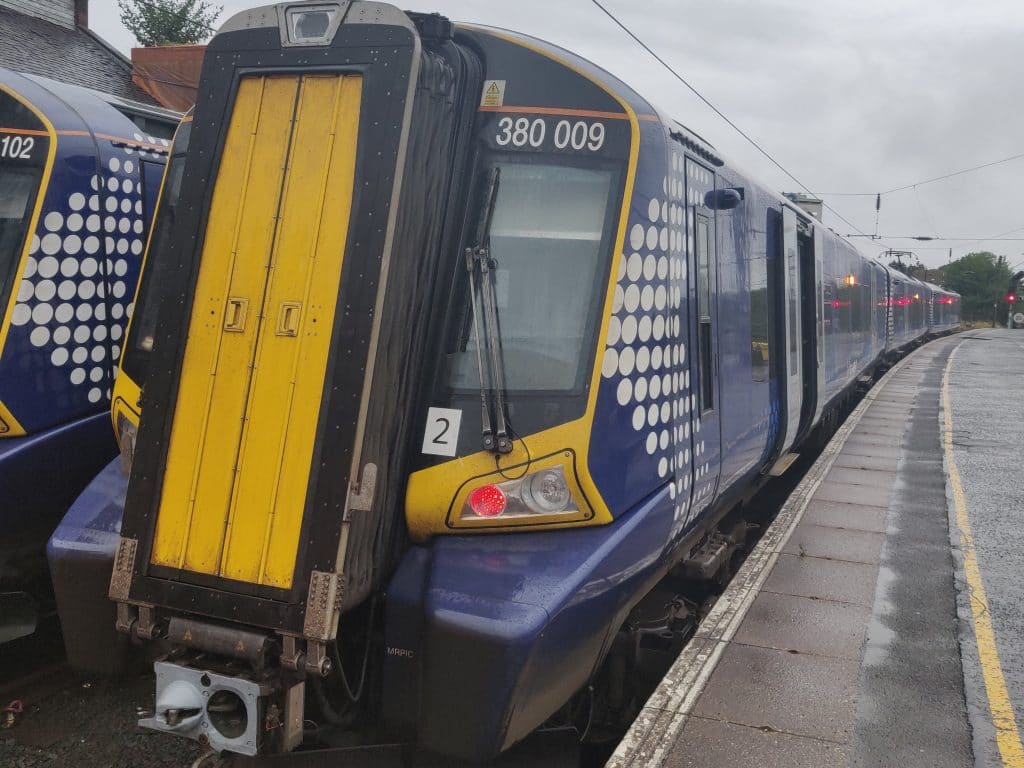
I stayed on the train at Stanraer. I could have remained in my seat all the way back to Glasgow, taking the same route as the train out, but I changed at Ayr onto an electric ScotRail class 380 . This ran directly along the Clyde back to Glasgow, instead of going via Kilmarnock, saving several miles and quite a bit of time. I’ve made this journey several times before and it’s pleasant enough with its golf courses and glimpses of water. The train was fine, and better than the last time I rode on this line. On that occasion the toilet door was locked out of use, but a steady flow of dodgy-looking liquid flowed under it and along the carriage floor.
I arrived back at Central on time at 19:11. A short walk led me to my hotel: the Glasgow Point A. Cheap, with no desk in the room. But adequate, comfortable, and air-conditioned. The plastic wall had pre-moulded pockets for the TV remote control and for bits and bobs. Clever.
I wandered out for food. Ah, a Handmade Burger Company. I’ve eaten in them before, in Leicester and in Wakefield, and had decent enough fare. But not this time. I should have been warned: the place was almost empty. Those in there seemed depressed, and the staff seemed to have lost the will to live. The burger was dry, the bun worse. A look at my phone showed that recent TripAdvisor reviews were terrible. Apparently the chain had been bought out of administration a few years ago and I suppose the new owners lack the passion of the founders. But it’s time for bed.